Arts & Culture

Burton and Dreher share similar aesthetic views about Christianity and the past.

Speculative futurism isn’t mentally escaping into a future that is either far more dystopic than our present or far more utopic than we should expect — nihilistically leaning into our sense of dread and doom, or engaging an escapist fantasy that all will be better someday and calling this ungrounded vision “hope” can both be momentarily comforting. A speculative futurist ecclesiology looks at every fault line exposed by this pandemic alongside every gift and grace it illuminates.

Julia Alvarez is a Dominican American novelist, poet, and recipient of a National Medal of Arts award. Her latest novel, Afterlife, came out in April, and her latest children’s book, Already a Butterfly: A Meditation Story, will be released in June. “A Glimpse of the Garden,” an essay by Alvarez on centering prayer, appears in the June issue of Sojourners magazine. Alvarez spoke with editorial assistant, Hannah Conklin, about her newly released books, the connection between her work and spiritual practices, and finding hope during the COVID-19 pandemic.

CONFESSION: I HAVE a bone to pick with the word “curated” this month. I’m finding that the word, while generally useful in art contexts, let me down during Lent this year.
Let me explain.
“Curation” evolved from the word “curare” (to take care of) but, as it exists now, covers anything from making playlists to putting on a painting exhibition. I don’t have an issue with the chameleonic nature of the term, though I know it’s beginning to vex actual museum curators. What is difficult for me to wrap my mind around is the fussiness that curation implies.
It’s synonymous with caring for objects and, subsequently, caring for an audience by displaying the objects in an interesting and informative way. But, as a representation of spiritual wilderness, Lent seems diametrically opposed to the idea of a carefully considered experience. In Lent, nothing is planned. This year, I simply showed up in the metaphorical desert and started walking.
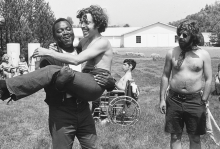
Lanyards and Legislation
Camp Jened, a former summer program for teens with disabilities, is the focus of the new documentary Crip Camp: A Disability Revolution. Co-directed by an attendee of the camp, with an overview of the relationships and activism that began there, Crip Camp is immensely prophetic and empowering. Netflix.

THE HYMN “I Sing a Song of the Saints of God” is one of my favorites in the Episcopal tradition, usually sung on All Saints Day. It concludes with the line, “For the saints of God are just folk like me / And I mean to be one, too.” It’s a reminder of the people in our lives—living and otherwise—who are everyday saints, not canonized but important in our formation.
In Dick Johnson Is Dead, filmmaker Kirsten Johnson celebrates her father, one such everyday saint. Dick isn’t actually dead, but he has been diagnosed with Alzheimer’s. How much of his life remains isn’t certain, but Johnson is determined to show him just how well he’s loved by trying to rid him of some of his fear of death.
Johnson does this in a darkly funny way that’s true to her dad’s mischievous streak: She collaborates with him on a series of staged scenes depicting his death from a variety of accidents. Dick is crushed by an air conditioner, falls down stairs, is hit by a construction worker’s nail-filled board, and more. “Everyone dies,” Johnson reminds us, even the people we love the most.

LIKE MOST POETS, she is largely unknown, but 97-year-old Catherine de Vinck can live with that. She has a dozen published volumes to her credit, a collection titled The Confluence of Time that she is working to publish, and the love of Christians drawn to the sometimes-shaky Jacob’s ladder of contemplation and social action. Thomas Merton was among her readers.
“Nothing stands still long enough / for us to find the first imprint / to grasp the pure moment of origin. / How then can we see the world as it is,” she writes in her poem “Ever-Changeless/Even-Changing.”
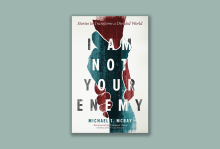
THERE'S A THEORY in peacebuilding that it can take as long to heal from a conflict as the conflict itself lasted. Depending on whom you ask, the conflict in Northern Ireland lasted 800 years, 400 years, or 30 years. The Good Friday Agreement officially ended the violence in 1998. Any way you spin it, this place isn’t very far along the healing journey.
The violence here lasted so long that it became almost normal. In my last taxi ride during grad school, the driver picked me up on the Antrim Road. “Do you like living here?” I asked. “I liked it better in the good old days—20 to 30 years ago,” he said. “It weren’t that violent. It were a pretty stable time, other than the bombs and guns and murders.”
I asked him if he’d been affected much by the violence. “No, not too much,” he said. “I mean, there was the time I saw my brother walking down the Falls Road, and a black taxi pulled up, rolled down its window, and blew his head off. I remember seeing my mother trying to put his brains back in.”

IN HER LATEST book, writer D.L. Mayfield welcomes readers on a journey of seeing. This essay collection weaves an exploration of the desires embedded in the American Dream with stories of Mayfield’s own social justice conversion and portraits of her Portland neighborhood.
These narratives of how colonialism, capitalism, racism, and consumerism store themselves in privileged American hearts invite self-reflection. Mayfield challenges the American Dream’s toxic individualism, dividing the book into four themes: affluence, autonomy, safety, and power. “We do not care that people will suffer and die,” she writes, “due to our own desire for safety.”
Mayfield reflects on her own awakening and exposure to xenophobic faith communities, where she began to have “serious problems reconciling the Suffering Servant with a conservative religious agenda.” The text also walks her readers through the gentrification of her neighborhood and how her community is affected by travel bans, the U.S. education system, and other aspects of local and national politics.

(“Oh I’ll leap up. Who pulls me down?”—
“Doctor Faustus,” by Christopher Marlowe)
Now can I join this dance?
See, I am thinner than vacuum.
I can kneel toward the sun
at the very angle of prayer
and feel the counterpoint
pulse through my veins.

Some mornings I drive to the duck pond
instead of writing poems. I can’t remember
how to keep words coupled to the truth.
So much lying has torn words loose
from what they stood for. Remember,
back when we agreed on their meanings?
I’d say honey for instance, and you could
taste it. Once you said freedom
and I saw doves rising from your shoulders.
We shared language so we were not alone.
We both loved words as if we could see them:
like ducks bobbing on a pond, dipping,
scooping, swabbing insects from the air.

ON MARCH 25, 1911, the prominent British suffragette Sylvia Pankhurst, visiting the U.S. on a speaking tour, was suddenly notified about a grotesque tragedy on New York’s Lower East Side. In what would come to be known internationally as the Triangle Shirtwaist Factory fire, 146 immigrant garment workers—mostly women—had died. Locked inside the workplace, they had no chance of escape. The event changed Pankhurst’s life.
At this point, Pankhurst had already been in disagreement with her mother and older sister over their positioning of the Women’s Socialist and Political Union, a women’s suffrage advocacy group where she also worked. Her mother and older sister were moving it away from its leftist roots, marginalizing working women and emphasizing the role of wealthy women whose prominence helped drum up great media coverage for the cause.
In New York, however, Sylvia was getting deeply involved with militant working-class women tired of being pushed aside by blue-blooded suffragettes. The laundry workers’ strikes greatly impressed Pankhurst, as did the garment workers’ determination to make sure employer abuses like those that caused the Triangle fire deaths never happened again.
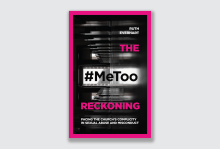
“O LORD, HOW long shall I cry for help, and you will not listen?” (Habakkuk 1:2). Ruth Everhart opens her heart-wrenching new book, The #MeToo Reckoning, with this lamentation. In a nation where, according to the Centers for Disease Control and Prevention, more than one in three women are sexually assaulted in their lifetime, lamentation and tears seem a fitting place to start. But Everhart reminds us that to lament is not merely to cry out in anguish. To lament is also to bring pain to light, to air wrongs suffered, and, in the same impassioned breath, to call for justice.
It is this more fulsome form of lamentation that frames Everhart’s book and undergirds her prophetic pronouncement against churches, calling on them to become braver and safer spaces, spaces more protective of the vulnerable, more supportive of victims and survivors, and more committed to seeking justice on their behalf.
Throughout The #MeToo Reckoning, Everhart, a Presbyterian pastor, recounts the incidents of sexual assault that she and others suffered and survived. From being raped inside a church to being assaulted by an elder on an overnight youth trip, these stories make for difficult reading. But they are important reading. Until we face the reality and extent of sexual assault, we will neither be able to properly support its victims nor bring this predatory behavior to an end.
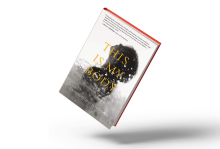
IS THERE A difference between being committed to one’s faith and being obsessed with it? This question is indirectly posed in Cameron Dezen Hammon’s debut book, This is My Body: A Memoir of Religious and Romantic Obsession, which connects the hope, despair, and desire that someone can feel about a love interest or God.
The memoir spans about 15 years of Hammon’s life and describes her relatable parenting, money, work, and marriage hardships. Equally relatable is her struggle with the approaches to these issues presented by a series of Houston megachurches for which she and her husband act as music ministers. These churches preach a hierarchical (as well as homophobic and misogynistic) version of Christianity in which obedience to God will lead to success and happy marriages. An inclusive feminist, Hammon doesn’t wholeheartedly subscribe to this doctrine, but neither does she know how to find meaning outside of it.
About her marriage, she writes, “I believe, or think I’m supposed to believe, that God will fix this. Fix us. Fix my loneliness, meet my needs. Or if God is not meeting my needs, then the fault lies with me.”

ACCORDING TO ARISTOTLE'S Poetics, art is supposed to imitate life. However, Oscar Wilde claimed that life more often imitates art. In the case of the recent Netflix movie The Two Popes and warring camps within the Catholic Church, it may be hard to tell which is which.
The Two Popes —which depicts an imagined relationship between Pope Emeritus Benedict XVI and his successor, Pope Francis—was bound to inflame tensions between those who believe that Francis wants to toss out historic church teachings on marriage and sexuality and those who suspect that anyone with a soft spot for the Latin Mass wants to bring back the Inquisition. Then, within weeks of the movie’s release, we had the spectacle of Benedict appearing as co-author on a book about priestly celibacy that seemed like a timed rebuke to the limited openness to ordaining married men expressed at the Amazon Synod that was called by Francis. Benedict later asked that his name be removed from the book.
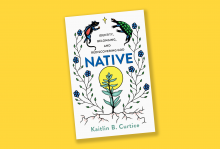
Departures and Arrivals
The Penguin Book of Migration Literature, edited by St. John’s University professor Dohra Ahmad, with a foreword by the Haitian American writer Edwidge Danticat, includes fiction, poetry, and memoir from the 18th century onward. From abolitionist Olaudah Equiano to Zadie Smith, this anthology honors the lives of migrants. Penguin Classics.

TWO WEEKS AFTER Kanye West released a gospel album with watered-down theology in October 2019, British singer-songwriter FKA Twigs dropped a marvelous piece of sparse electronica with a spiritual tenor. Twigs’ album is gospel in its theological significance. West’s record is not.
Titled Magdalene, the 32-year-old Twigs’ second album is a “revelation,” according to Pitchfork. Throughout the album, the dancer-turned-R&B-genre-bender finds strength in the story of Mary Magdalene. The record’s title track focuses on the Magdalene and the social implications of Jesus’ relationship with her.
Twigs frames the album as a feminist reconsideration of Mary’s story, pushing back on the fact that her narrative was ultimately told by male writers. Outside of Jesus’ family, she is the woman most mentioned in the gospels. She was a patron of Jesus’ ministry and among the first to have seen him resurrected. However, throughout much of history she has been conflated with the “sinful woman” in Luke 7 and, as a result, seen as sexually promiscuous. Twigs pushes against this patriarchal gaze and turns to the Magdalene for inspiration.

AT THE TIME most people head home after a typical workday, four musicians are just getting started. In a living room filled with holiday decorations and religious artwork, with inspirational phrases on the walls and bookshelves, Darren Calhoun, Leslie Michelle, Hannah Rand, and Gary Rand are rehearsing.
Together, with Leonora Rand, they are The Many, a Chicago-based, social justice-focused worship band that pulls from gospel and indie pop to sing about topics not usually mentioned in worship music or church. Their songs touch on police brutality, LGBTQ and immigrant inequalities, economic hardship, identity and uncertainty about faith and God, and doubt and justice amid violence.
“We were trying to find some songs that could give honest voice to our congregation, to what we were dealing with,” says producer Gary Rand, a longtime musician and former director of worship at LaSalle Street Church in Chicago, as well as former director of worship and adjunct professor at McCormick Theological Seminary for 20 years. He says the band always felt a need for this kind of music, but once the group solidified in 2016 with its current members, its mission of speaking truth with a social justice lens to community issues took off.

Mexican American writers render their world — unrecognized and illegible — visible and legitimate.
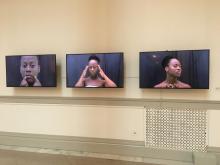
When who you are has been defined by outside representatives, to keep from slipping away you have to grasp onto what is tangible, what is real, what you know to be you. There is a consistent reconciliation of self, from you to your audience, you to your work, and you to yourself.